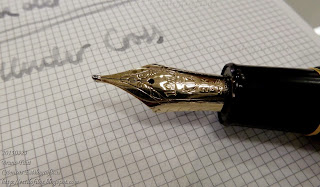I finished
the previous Chronicle with the picture of an interesting but mostly unknown pen—a Surat. Now, given the reactions that picture triggered it seems that further information is in order.
I discovered this pen through a fellow stylophile from Kansai (Osaka region). Mr. Mochizuki had found a big number of them at some flea market. And, even better, many of them were complete with box and papers—like the one I am now presenting.
On the manual, the pen is described as featuring an original filling system names as Nakahara-system (中原式, Nakahara-
shiki). However, upon opening the pen we only see a bulb filler –a rigid cylinder closed with a rubber sac. Nothing new as bulb fillers were one of the earliest self-filling systems and can easily be found in American, European and
Japanese pens.
 Basic parts of the Surat. In the middle, the "magic center", or breathing tube. Note the conic piece on the left end. It works as a valve against the section of the pen.
Basic parts of the Surat. In the middle, the "magic center", or breathing tube. Note the conic piece on the left end. It works as a valve against the section of the pen.
The Surat, though, does present an original detail. Inside the ink deposit, the breathing tube is not attached to the feed. On the contrary, this breathing tube –named “magic center” by the manufacturer— can move back and forth inside the deposit. The conic piece on the front part works like a valve to avoid emptying the deposit when depressing the rubber bulb. In this regard, this system reminds of two Pilot’s creations:
the pulsated piston A-shiki, and the current
CON-70 converter. The system works efficiently and the deposit is filled up in about 10 strokes of the bulb. This means that the ink enters the deposit through the “magic center” despite not being attached to the feed.
On its side, the manufacturer also claimed that this “magic center” balanced the internal pressure and prevented ink leaks. Whether this is real or just hype is at anybody’s guess.
 The blind cap displays, on this picture, the black button that touches the rubber bulb enough to release a drop of ink out of the feed. A clear mistake in the design.
The blind cap displays, on this picture, the black button that touches the rubber bulb enough to release a drop of ink out of the feed. A clear mistake in the design.
The Surat also displays an unsettling detail—the blind cap protecting the bulb has some sort of push button at the end. Its movement is not wide enough to depress the rubber bulb in any efficient way and, therefore, it cannot be used to ink the pen. But it does touch the bulb enough to release a small drop of ink through the feed. The manual simply mentions the existence of this button and does not comment on its actual function. This problem is just a flaw in the design, but does not affect the writing performance of the pen.
Finally, the deposit can be unscrewed from the section and the pen could also be filled with an eyedropper or a syringe.
These are the dimensions of the pen:
- Length closed: 129 mm
- Length open: 115 mm
- Length posted: 151 mm
- Diameter: 12.5 mm
- Weight (dry): 12.1 g
- Ink deposit: 2.2 ml
All in all, this pen seems another experiment in filling systems carried out in Japan in the last 100 plus years.
The nib is an extra-fine point with a hint of flexibility. It is made of stainless steel and carries the following inscription: “WARRANTED / HARDEST / IRIDIUM / STAINLESS / SPECIAL / PEN”.
The pen is also signed on the barrel (“SURAT / TRADE MARK / PATENTED 6564”). The instruction sheet speaks of Tokyo Suishindô as the manufacturing company. No address is provided.
And nothing else we know so far. This is just another pen that would rarely make its way in any book on pens despite its interesting features. But a detailed description of the technical evolution in pens would allow for some way of dating it. My best guess is that this Surat was manufactured around 1950.
My thanks to Mr. Mochizuki and to Poplicola-san.
Universal, music nib – Pelikan 4001 Brilliant Brown
Bruno Taut
Nakano & Shinjuku, July 2014
etiquetas: Surat, soluciones técnicas






























































